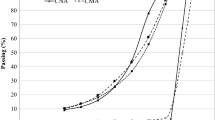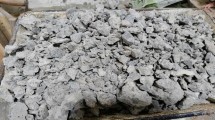Abstract
Accurate characterization of aggregates plays an important role in mixture proportioning of concrete mixes. Decisions made during the concrete design phase in terms of characterization techniques adopted for quantification of specific gravity or water absorption affect the development of fresh properties during the construction phase as well as impacting the long term performance of concrete. Manufactured aggregates such as recycled concrete aggregates (RCA) and lightweight aggregate (LWA) are more absorptive than natural aggregate. Due to the thrust on construction of sustainable structures usage of LWA and RCA has increased significantly in the last decade. In this study, standard ASTM techniques adopted for porosity and specific gravity measurement of aggregates were compared with automated testing equipment such as the helium pycnometer and the envelope density analyzer. Porosity of different aggregates obtained using different test methods was compared with image analysis. Pore diameter characterization of different RCA was conducted using image analysis.














Similar content being viewed by others
References
Bentz DP, Jenson OM (2004) Mitigation strategies for autogenous shrinkage cracking. Cem Concr Compos 26(6):677–685
Henkenseifken R, Castro J, Bentz D, Nantung T, Weiss J (2009) Water absorption in internally cured mortar made with water-filled lightweight aggregate. Cem Concr Res 39(10):883–892
Jensen OM, Hansen PF (2001) Water-entrained cement-based materials: i. principle and theoretical background. Cem Concr Res 31(4):647–654
Mehta PK (2001) Reducing the environmental impact of concrete. Concr Int 6:61–66
Winslow D (1994) The pore system of coarse aggregates. In: Klieger P, Lamond J (eds) Significance of tests and properties of concrete and concrete-making materials STP 169C. ASTM, Philadelphia, pp 429–437
Deshpande YS (2006) Evaluation of commercial rapid-setting materials and rapid-setting self-consolidating concrete for dowel bar retrofit applications. Ph.D. thesis. School of Civil Engineering, Purdue University, West Lafayette
Al-Negheimish AI, Alhozaimy MA (2008) Impact of extremely hot weather and mixing method on changes in properties of ready mixed concrete during delivery. ACI Mater J 105(5):438–444
ASTM-C127 (2008) Standard test method for density, relative density (specific gravity), and absorption of coarse aggregate. Annual Book of ASTM Standards, USA
Saxer EL (1956) A direct method of determining absorption and specific gravity of aggregates. Rock Prod 87:77–79
Black RW (1986) The determination of specific gravity using the siphon can method. Cement, concrete and aggregates. American Society for Testing and Materials, Philadelphia, p 46
Snyder MB (2008) Performance of concrete pavement constructed using recycled concrete aggregate—FHWA study update. In: Concrete conference continuing education and conference center, St. Paul, MN
Abbas A, Fathifazl G, Fournier B, Isgor OB, Zavadil R, Razaqpur AG, Foo S (2009) Quantification of the residual mortar content in recycled concrete aggregates by image analysis. Mater Charact 60:716–728
Go′mez-Sobero′n JMV (2002) Porosity of recycled concrete with substitution of recycled concrete aggregate: an experimental study. Cem Concr Res 32:1301–1311
Tam VWY, Gao XF, Tam CM, Chan CH (2008) New approach in measuring water absorption of recycled aggregates. Construct Build Mater 22(3):364–369
Vitton S, Lehman M, Van Dam T (1998) Automated soil particle specific gravity analysis using bulk flow and helium pycnometery. In: Nondestructive and automated testing for soil and rock properties, San Diego, USA
Micrometrics (2010) http://www.micromeritics.com/Pressroom/Press-Release-List/Combining-Skeletal-and-Envelope-Volume-Measurements-to-Determine-Total-Pore-Volume-and-Percent-Porosity.aspx
MultiSpec (2010) http://cobweb.ecn.purdue.edu/~biehl/MultiSpec/
ImageJ (2010) http://rsbweb.nih.gov/ij/
Landgren R (1994) Unit weight, specific gravity, absorption and surface moisture. In: Significance of tests and properties of concrete and concrete making materials, ASTM STP 169C. ASTM International, West Conshohocken, PA, pp 421–428
Cusson D, Hoogeveen T (2008) Internal curing of high-performance concrete with pre-soaked fine lightweight aggregate for prevention of autogenous shrinkage cracking. Cem Concr Res 38:757–768
Henkenseifken R, Bentz DP, Nantung T, Weiss J (2009) Volume change and cracking in internally cured mixtures made with saturated lightweight aggregate under sealed and unsealed conditions. Cem Concr Compos 31:427–437
Lura P, Bentz DP, Lange DA, Kovler K, Bentur A, Breugel KA (2006) Measurement of water transport from saturated pumice aggregates to hardening cement paste. Mater Struct 39:861–868
Hearn N, Hooton DR, Mills RH (1994) Pore structure and permeability. In: Klieger P, Lamond J (eds) Significance of tests and properties of concrete and concrete making materials STP 169C. ASTM, Philadelphia, pp 240–262
Mindess S, Young JF, Darwin D (2002) Concrete. 2nd edn. Prentice Hall, Upper Saddle River
Deshpande Y, Hiller JE, Shorkey C (2009) Volumetric Stability of concrete using recycled concrete aggregates. In: Brittle matrix composites -9. Woodhead Pubslihing Limited, Warsaw, pp 301–312
Hiller JE, Deshpande Y, Qin Y, Shorkey C, Peterson K (2010) Efficient use of recycled concrete in transportation infrastructure. Michigan Department of Transportation, MI, USA
Zaharieva R, Buyle-Bodin F, Wirquin E (2004) Frost resistance of recycled aggregate concrete. Cem Concr Res 34(10):1927–1932
Ajdukiewicz A, Kliszczewicz A (2002) Influence of recycled aggregates on mechanical properties of HS/HPC. Cem Concr Compos 24:269–279
Acknowledgements
The authors would like to thank Mr. Cory Shorkey and Dr. Karl Peterson for their valuable assistance in sample preparation for image analysis.
Author information
Authors and Affiliations
Corresponding author
Rights and permissions
About this article
Cite this article
Deshpande, Y.S., Hiller, J.E. Pore characterization of manufactured aggregates: recycled concrete aggregates and lightweight aggregates. Mater Struct 45, 67–79 (2012). https://doi.org/10.1617/s11527-011-9749-2
Received:
Accepted:
Published:
Issue Date:
DOI: https://doi.org/10.1617/s11527-011-9749-2




